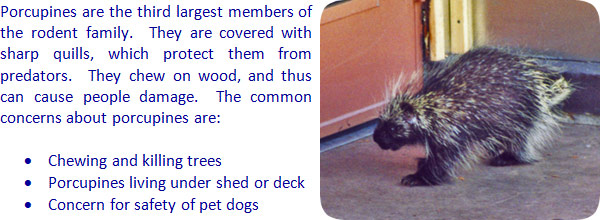- info@wildlifeanimalcontrol.com
Call us for help in your town
Wildlife Control Education
Porcupine Trapping - How To Trap

Need porcupine removal in your hometown? We service over 500 USA locations! Click here to hire us in your town and check prices - updated for year 2020.
How to Trap a Porcupine
The porcupine is famous for its head to toe soft fur coat topped with thousands of thin yet sharp needles. At their largest, the needles are nearly a foot long. This defense mechanism is hurtful enough to deter even the most aggressive and hungry of predators. Porcupines occasionally make their way into the yards and gardens of humans, where they can tear up grass and become more of a pest. In these cases, it is very easy to catch a porcupine and relocate it far from your home.
If you find a porcupine in your yard, it is probably because your trees have particularly appetizing bark and they have been wandering for food. Porcupines have large front teeth perfect for gnawing on wood—their preferred diet in addition to leaves and plant buds. Porcupines may even munch on wood products, such as canoe paddles or wooden furniture. Their teeth are nearly constantly growing which gives them a constant need to chew on something.
Even the thought of catching a porcupine is intimidating because of their thousands of prickly quills. However, with some thought out planning and a little waiting, capturing a porcupine and all of its 30,000 quills is definitely feasible.
The first thing you might try is simply sacking the porcupine. You can herd the porcupine into a large sack (such as an old feed sack or extra large pillow case) by coming near the porcupine and nudging it with a stick. The needles may push through the fabric so wear leather gloves to protect your hands in case the needles come near your skin.
If you decide to use a trap of some sort, baiting the porcupine is an important step in making sure your trap works. As mentioned, porcupines love fresh bark and leaves. Cut up fruit, such as apples, with salt also work well because you can place some of the bait outside the trap and make a trail inside the trap. With a little sleuthing and patience, you can also figure out where their den is and place a trap outside of the opening.
Conibear traps are effective but lethal traps for many critters, including porcupines. This method is not recommended since it is just as easy to catch and release an animal. If you feel your own life is threatened, it may be necessary to take this measure. Conibear traps are spring loaded and collapse on the head and neck of porcupines once the release is triggered, crushing the head of the porcupine. Conibear traps are extremely dangerous and if you are setting them up in your yard, a house pet such as a dog or cat, can easily wander into one.
Porcupine live traps are quite easy to set up. Live traps for porcupines generally run by the dimensions of 11 ft x 12 ft x 30 ft. Locate the trap where you have observed the porcupine to travel, eat, dig or hang around. Using vegetative lures, such as the apple and salt trick, will tempt the porcupine by their sense of smell. Cover the bottom of the trap with vegetation and dirt to disguise it. Placing leaves and shrubs on the outside and top of the cage is also a good idea.
Many live traps made professionally are now made with lightweight but strong metal and wire. They have a sliding and locking front door that will snap down once triggered by the porcupine. Handles atop the trap make it easy to carry and transport. You can also opt into a plexi-glass cover for the trap, which may protect you if the quills are long enough to poke outside of the metal cage.
Once you have caught a porcupine, relocation is pretty simple. Make sure you drive at least 20 miles away, into a non-human inhabited area. If you relocate the animal in other human-developed areas where food is scarce they will wander into more human yards or even make its way back to your home. Porcupines will travel many miles in search of food. Because of increased urbanization, the forest ecosystems where many porcupines live have changed and their food source is scarcer. This has caused them to leave their native habitat in search of food.
Porcupines are not aggressive animals and they only come into conflict with humans when they have been forced to search for food because of their damaged ecosystem. Catching porcupines humanely is just as easy, if not easier, than killing them. If you take a little ingenuity and a little patience, you can catch a porcupine and relocate it with no problem.
More in-detail how-to porcupine removal articles:
Information about how to kill a porcupine - with poison or other methods.
Information about how to keep porcupines away - prevention techniques.
Information about how to catch a porcupine - remove one stuck in the house.
Information about porcupine repellent - analysis of types and effectiveness.
This site is intended to provide porcupine education
about how to trap a porcupine in your house or
property and and information about porcupine trapping, so that you can make an informed decision
if you need to deal with a porcupine problem. This site provides many porcupine control articles and strategies, if
you wish to attempt to solve the problem yourself. If you are unable to do so, which is likely with many
cases of porcupine removal, please go to the home page and click the USA map, where I have wildlife removal experts
listed in over 500 cites and towns, who can properly help you with your nuisance porcupine.
Click here to
read more about how to get rid of porcupines.

















